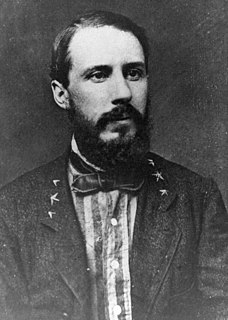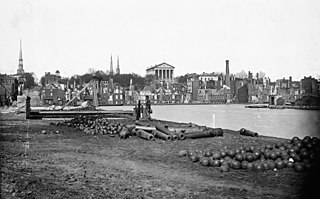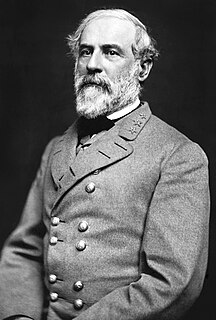Lee's origins
Fellman describes Robert E. Lee's singular position as the son of Henry "Light Horse Harry" Lee, a hero of the American War of Independence. His relatively impoverished upbringing, after his father lost most of his fortune and suffered injuries that later killed him after being attacked by a mob in Baltimore in 1812. But how he remained part of the close-knit elite of Virginia.

Major-General Henry "Light-Horse Harry" Lee III was an early American Patriot and politician. He served as the ninth Governor of Virginia and as the Virginia Representative to the United States Congress. Lee's service during the American Revolution as a cavalry officer in the Continental Army earned him the nickname by which he is best known, "Light-Horse Harry". He was the father of Robert E. Lee, commander of the Confederate armies in the American Civil War.

Baltimore is the most populous municipality in the U.S. state of Maryland. Baltimore was established by the Constitution of Maryland as an independent city in 1729. With a population of 602,495 in 2018, Baltimore is the largest such independent city in the United States. As of 2017, the population of the Baltimore metropolitan area was estimated to be just under 2.802 million, making it the 21st largest metropolitan area in the country. Baltimore is located about 40 miles (60 km) northeast of Washington, D.C., making it a principal city in the Washington-Baltimore combined statistical area (CSA), the fourth-largest CSA in the nation, with a calculated 2018 population of 9,797,063.
Young Robert E. Lee made a great impression as a cadet at West Point. Despite his lack of wealth he married Mary Anna Randolph Custis, the great-granddaughter of Martha Washington and step-granddaughter of George Washington. And the problems he had when he had to manage her father's plantation after she inherited it. Fellman discusses the accusations made that Lee had had some runaway slaves whipped, and reckons them to be broadly true.

Mary Anna Randolph Custis Lee was the great-granddaughter of Martha Custis Washington and wife of Robert E. Lee, the prominent career military officer who commanded the Confederate Army of Northern Virginia during the American Civil War. They married at her parents' home, Arlington House, in Virginia in 1831, and had seven children together; he predeceased her by three years.

George Washington was an American political leader, military general, statesman, and Founding Father who served as the first president of the United States from 1789 to 1797. He led Patriot forces to victory in the nation's War for Independence. He presided at the Constitutional Convention of 1787 which established the U.S. Constitution and a federal government. Washington has been called the "Father of His Country" for his manifold leadership in the formative days of the new nation.
Fellman argued that Lee successfully modelled himself on the ideal of George Washington, achieving a very high degree of self-control according to the ideals of the southern gentry. That though Lee had reservations about slavery, he was against abolishing it and wished that all freed blacks could be sent back to Africa. Fellman also argues that Lee was out of tune with the rising tide of democracy, North and South.

The American Civil War was a civil war fought in the United States from 1861 to 1865, between the North (Union) and the South (Confederacy). The most studied and written about episode in U.S. history, the Civil War began primarily as a result of the long-standing controversy over the enslavement of black people. War broke out in April 1861 when secessionist forces attacked Fort Sumter in South Carolina shortly after Abraham Lincoln had been inaugurated as the President of the United States. The loyalists of the Union in the North, which also included some geographically western and southern states, proclaimed support for the Constitution. They faced secessionists of the Confederate States in the South, who advocated for states' rights to uphold slavery.

The Confederate States of America, commonly referred to as the Confederacy, was an unrecognized country in North America that existed from 1861 to 1865. The Confederacy was originally formed by seven secessionist slave-holding states—South Carolina, Mississippi, Florida, Alabama, Georgia, Louisiana, and Texas—in the Lower South region of the United States, whose economy was heavily dependent upon agriculture, particularly cotton, and a plantation system that relied upon the labor of African-American slaves. Convinced that white supremacy and the institution of slavery were threatened by the November 1860 election of Republican candidate Abraham Lincoln to the U.S. presidency on a platform which opposed the expansion of slavery into the western territories, the Confederacy declared its secession from the United States, with the remaining states becoming known as the Union during the ensuing American Civil War. According to Confederate Vice President Alexander H. Stephens in his famous Cornerstone Speech, Confederate ideology was centrally based "upon the great truth that the negro is not equal to the white man; that slavery, subordination to the superior race, is his natural and normal condition".

George Edward Pickett was a career United States Army officer who became a major general in the Confederate States Army during the American Civil War. He is best remembered for leading Pickett's Charge, the futile and bloody Confederate offensive on the third day of the Battle of Gettysburg that bears his name.

Edward Porter Alexander was a military engineer, railroad executive, planter, and author. He served first as an officer in the United States Army and later, during the American Civil War (1861–1865), in the Confederate Army, rising to the rank of brigadier general.

The Confederate States Army was the military land force of the Confederate States of America (Confederacy) during the American Civil War (1861–1865), fighting against the United States forces. On February 28, 1861, the Provisional Confederate Congress established a provisional volunteer army and gave control over military operations and authority for mustering state forces and volunteers to the newly chosen Confederate president, Jefferson Davis. Davis was a graduate of the U.S. Military Academy, and colonel of a volunteer regiment during the Mexican–American War. He had also been a United States Senator from Mississippi and U.S. Secretary of War under President Franklin Pierce. On March 1, 1861, on behalf of the Confederate government, Davis assumed control of the military situation at Charleston, South Carolina, where South Carolina state militia besieged Fort Sumter in Charleston harbor, held by a small U.S. Army garrison. By March 1861, the Provisional Confederate Congress expanded the provisional forces and established a more permanent Confederate States Army.

During the American Civil War, the Union Army referred to the United States Army, the land force that fought to preserve the Union of the collective states. Also known as the Federal Army, it proved essential to the preservation of the United States as a working, viable republic.

Richard Stoddert Ewell was a career United States Army officer and a Confederate general during the American Civil War. He achieved fame as a senior commander under Stonewall Jackson and Robert E. Lee and fought effectively through much of the war, but his legacy has been clouded by controversies over his actions at the Battle of Gettysburg and at the Battle of Spotsylvania Court House.

In the context of the American Civil War (1861–65), the border states were slave states that did not declare a secession from the Union and did not join the Confederacy. To their north they bordered free states of the Union and to their south they bordered Confederate slave states. Of the 34 U.S. states in 1861, nineteen were free states and fifteen were slave states. Two slave states never declared a secession or adopted an ordinance: Delaware and Maryland. Four others did not declare secession until after the Battle of Fort Sumter and were briefly considered to be border states: Arkansas, North Carolina, Tennessee and Virginia—after this, they were less frequently called "border states". Also included as a border state during the war is West Virginia, which was formed from 50 counties of Virginia and became a new state in the Union in 1863.

The President of the Confederate States of America was the elected head of state and government of the Confederate States. The president also headed the executive branch of government and was commander-in-chief of the Army and Navy, and of the militia of the several states when called into Confederate service.

The Guns of the South is an alternate history novel set during the American Civil War by Harry Turtledove. It was released in the United States on September 22, 1992.

The Lost Cause of the Confederacy, or simply the Lost Cause, is an American historical negationist ideology that holds that the cause of the Confederacy during the American Civil War was a just and heroic one. The ideology endorses the supposed virtues of the antebellum South, viewing the war as a struggle primarily for the Southern way of life or "states' rights" in the face of overwhelming "Northern aggression". At the same time, the Lost Cause minimizes or denies outright the central role of slavery in the outbreak of the war.

There is widespread disagreement among historians about the turning point of the American Civil War. A turning point in this context is an event that occurred during the conflict after which most modern scholars would agree that the eventual outcome was inevitable. While the Battle of Gettysburg in July 1863 is the event most widely cited as the military climax of the American Civil War, there were several other decisive battles and events throughout the war which have been proposed as turning points. These events are presented here in chronological order. Only the positive arguments for each are given.

George Hume Steuart was a planter in Maryland and an American military officer; he served thirteen years in the United States Army before resigning his commission at the start of the American Civil War. He joined the Confederacy and rose to the rank of brigadier general in the Army of Northern Virginia. Nicknamed "Maryland" to avoid verbal confusion with Virginia cavalryman J.E.B. Stuart, Steuart unsuccessfully promoted the secession of Maryland before and during the conflict. He began the war as a captain of the 1st Maryland Infantry, CSA, and was promoted to colonel after the First Battle of Manassas.

Richmond, Virginia, served as the capital of the Confederate States of America for almost the whole of the American Civil War. It was a vital source of weapons and supplies for the war effort, and the terminus of five railroads.

Appomattox is an opera in English based on the surrender ending the American Civil War, composed by Philip Glass, with a libretto by the playwright Christopher Hampton. The work had its world premiere at the San Francisco Opera on October 5, 2007, with a cast that included Dwayne Croft as Robert E. Lee and Andrew Shore as Ulysses S. Grant. The revised version commissioned and premiered by the Washington National Opera on November 14, 2015 expanded the work from 90' to 160' and added roles for Martin Luther King, jr. and Lyndon Johnson.
A large contingent of African Americans served in the American Civil War. 186,097 black men joined the Union Army: 7,122 officers, and 178,975 enlisted soldiers. Approximately 20,000 black sailors served in the Union Navy and formed a large percentage of many ships' crews. Later in the War, many regiments were recruited and organized as the "United States Colored Troops", which reinforced the Northern side substantially in the last two years. Both Northern free blacks and Southern runaway slaves joined the fight. Throughout the course of the war, black soldiers served in forty major battles and hundreds of more minor skirmishes; sixteen African Americans received the Medal of Honor.

The Military forces of the Confederate States, also known as Confederate forces, were the military services responsible for the defense of the Confederate States during its brief existence (1861-1865).

Slavery played the central role during the American Civil War. The primary catalyst for secession was slavery, especially Southern political leaders' resistance to attempts by Northern antislavery political forces to block the expansion of slavery into the western territories. Slave life went through great changes, as the South saw Union Armies take control of broad areas of land. During and before the war, slaves played an active role in their own emancipation, and thousands of slaves escaped from bondage during the war. On January 1, 1863, President Abraham Lincoln announced the Emancipation Proclamation, making 3 million blacks legally free. In the war, both sides used African Americans for military purposes; in the South as slave labor and in the north as wage labor and military volunteers. Over 100,000 ex-slaves fought for the Union and over 500,000 fled their plantations for Union lines. Religiosity and cultural expression also developed greatly during the war.

The Warrenton Junction Raid was a surprise attack by Confederate guerrilla warriors on a Union cavalry detachment during the American Civil War. The raid took place near a railroad junction in Virginia's Fauquier County, less than 10 miles (16 km) from the town of Warrenton. Confederate Major John S. Mosby led the attack against about 100 men from the Union's 1st (West) Virginia Cavalry. At first, the raid was very successful, as many of the Union soldiers surrendered to the rebels. The remaining portion of the surprised force was surrounded in a house, and two of their leaders were wounded. The house was set on fire, and the Union soldiers surrendered. As Mosby's men rounded up prisoners and horses, a detachment of the 5th New York Cavalry surprised the rebels and rescued most of the captured Union soldiers. After a short fight, more men from the 5th New York, and the 1st Vermont Cavalry, joined in the pursuit of Mosby's fleeing rebels.























